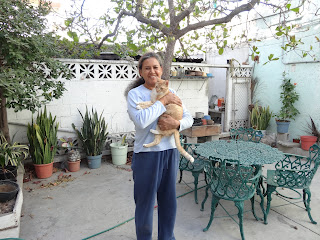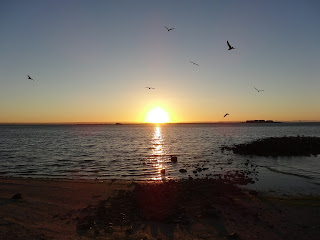Saturday March 9th - Friday March 15th
Al
Marchand warned me about the La Paz Eddy. You see, La Paz is one of those
unusual places that you come across from time to time travelling, where people
just seem to get stuck. I saw it at Lago Atitlan in Guatemala, in Salento in
Colombia, and once again in La Paz. People come for a few days, or a week, and
end up staying months, years or even the rest of their lives. Here they call it
the La Paz Eddy, perhaps because it's the boating community that is
particularly susceptible to it.
And so
I too swirled around. For over a week I spent my mornings going to the club at
the marina, drinking coffee and shooting the breeze with the greyhairs, before
heading to the boat to get it ready for the race. Sometimes during the morning
coffee hour, when I got tired of talking, I would just watch and listen. Arms
are folded over pot bellies, and grey hair sits over wide sunglasses. Snippetts
of conversation that I hear range from how much it costs to house prisoners in
US prisons "... and that's WITHOUT guards salaries...", to stories
from the military "...and I knew right then that I liked him!", to
the obligatory boat talk, and where to get Crocs or cheap insulin in La Paz.
Afterwards, on the boat, I scrubbed decks, fixed rigging, programmed
chartplotters, or whatever needed to be done. I was told that work on boats
should only be done with one hand, so there could be a beer in the other,
otherwise it would be too much like work. So no matter what I did, it always
seemed that the taste of coffee would only just be fading on my tongue as I
tasted the first beer of the day.
 |
| In the eddy |
 |
| The club |
In the
afternoons, I explored the charitable side of La Paz a little. I found an
orphanage, Ciudad Los Ninos, run by Father Fernando, which supports itself
partly by a printing business that it runs on site. I like this model, as it
makes it easy for people to support the kiddies, simply by choosing that place to
get their printing done. I also chatted with EPI, or Ecology Project
International, who do lots of youth education through excursions, workshops,
and school visits. Their focus is on sustainability and the environment, and
they are in La Paz partly because of the status the Sea of Cortes has as a
marine biodiversity hotspot.
In the
evenings I would either hang out with some of the more youthful sailors - I had
dinner on a boat one night, other we spent at the local burger joint and sailor
hangout, The Shack - or get to know some of the more interesting parts of the
La Paz nightlife with a couchsurfing friend, El Chepe. Chepe is a pretty cool
cat, an artist who works most of the year on a commercial fishing boat in
Alaska, and the rest painting murals in La Paz.
 |
| Julia |
The
days would end as they began, at Julia's place, where I was staying. Julia
worked at FANLAP, and at the community garden with Joel. She is a truly kind
soul, and was happy to have me as long as I needed. Julia's place was only a
short bike ride from the marina, and it was a source of fascination for me that
between riding along the malecon to the marina, and back again at the end of
the day, you could see so many pieces of La Paz that make it interesting.
You
can see fish swimming and jumping in the water everywhere near the shore, and a
little further out dolphins and seals make regular appearances. There are tours
to see the migrating whales, and whale sharks, and there are beautiful beaches,
bays and islands all around. So in addition to the many tourists, La Paz
attracts fishermen, sailors, surfers, and biologists alike. There is small but
determined band of artists, conservationists, and liberal-minded people,
resulting in art hangouts and events, community gardens and the like. Social attractors
are at work here too, as people look to escape the high cost of living in other
parts of Southern Baja, like Los Cabos. This gives rise to the broad expanses
of suburbia far away from the beautiful malecon, where people live under
sometimes difficult circumstances. Running water and electricity is not
available in some of these areas, while closer to the centre, there is
electricity, but running water only every other day, and sometimes only for
half a day. Of course, not running water you can drink, because everybody buys
their drinking water here (and in all of Baja California). These conditions
stand in stark contrast to the resorts and fancy hotels near the water, where
electricity and water are always on, and there are even golf courses, well-watered,
and maintained bright green. The image of those lush green expanses set against
a desert backdrop, for me, really sums up the madness you find in some places
in Mexico. This contrast is fuelled by tourism, part foreign, and part local.
It's perhaps surprising then, that the mixture of gringo and local Mexican
culture is pretty chilled. The gringo presence is significant, just not as
obtrusive and warping of the local culture as it is in other places.
As I
sit in my chair at the club de cruceros, I wonder if this is the contrasts, the
different people that makeup the gringos here. For every one that hasn't
bothered to learn Spanish and never leaves the marina, there will be someone
who has lived in town for years, speaks fluent Spanish, and works in a
charitable or conservation project. Musing on thoughts like this, I lean back
in my chair, reach out for my cup of coffee, and let the warm water of La Paz
carry me along, with the other flotsam and jetsam, towards Saturday, towards
the race.





I love lapaz!
ReplyDelete